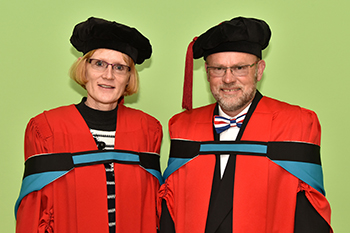
Barend Wentzel received his PhD at the Department
of Plant Sciences during the university’s
winter graduation ceremony.
He is pictured here with Prof Maryke Labuschagne,
professor in Plant Breeding at the UFS.
Photo: Charl Devenish
Barend Wentzel, an alumnus of the University of the Free State’s Department of Plant Sciences, is passionate about plant breeding.
He literally eats and lives wheat proteins. In 1989 he initiated a breeding programme on arum lilies. “This breeding programme is at an advanced stage,” he said. Besides reading, playing the piano and accordion, Barend, due to the nature of his research at the Agricultural Research Council, also experiments with different types of ciabatta recipes made from sour dough. “I usually make my own pizza on Saturday evenings,” he said.
He is working at the Agricultural Research Council – Small Grain (ARC-SG) at the Wheat Quality Laboratory where he established a Cereal Chemistry Laboratory.
Complexity of flour quality
He explains that the focus of his research is on wheat protein composition. “The research conducted for my PhD study explains the complexity of flour quality to a certain extent, and it further emphasises the influence of the environment and genetic composition on selected baking characteristics.
“Wheat protein can be divided into different types of protein fractions. These protein fractions contribute differently to dough properties and baking quality and the expression is affected by different components in the environment, including locality, rainfall and temperature.
“Protein content alone does, however, not explain the variation in baking quality parameters, such as mixing time, dough strength and extensibility, and loaf volume.
“Several methods can be applied to quantify the different protein fractions. I am using high-performance liquid-chromatography (HPLC). The procedure entails the separation of a wheat protein extract through a column with chromatographic packing material. The injected sample is pumped through the column (known as the stationary phase) with a solvent (known as the mobile phase). The specific procedure, size-exclusion high-performance liquid-chromatography (SE-HPLC), is also used by the university’s Department of Plant Breeding, as well as in several international Cereal Chemistry Laboratories,” said Barend.
Dough strength and to loaf volume
“One of the highlights from the study was the positive contribution of the albumin and globulin protein fractions to dough strength and to loaf volume. The findings were wheat cultivar specific and the growing environment influenced the expression. The contribution of these protein fractions was much larger than previously reported for South African wheat cultivars,” said Barend.
“Previous reports indicated that these protein fractions had a non-specific contribution to the gluten network during dough formation. The findings from this PhD justify further research on albumins and globulin proteins.”
The Cereal Chemistry Laboratory at ARC-SG is involved in postgraduate student training under Barend’s guidance. He serves as co-promoter for several MSc and PhD students. He is also a collaborator on an international project with the International Maize and Wheat Improvement Centre (CIMMYT) in Mexico. Barend is furthermore working on improving wheat quality for processing and health purposes as a member of the expert working group of the International Wheat Initiative.